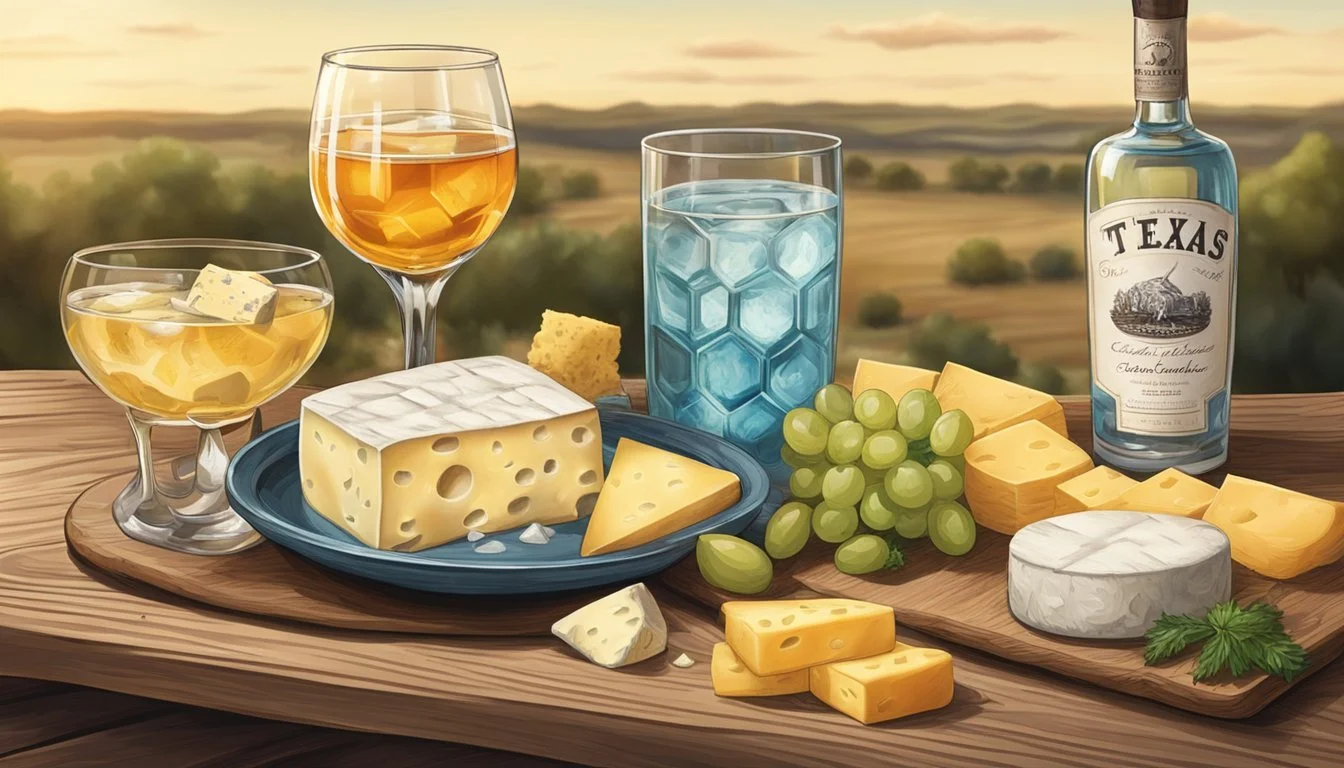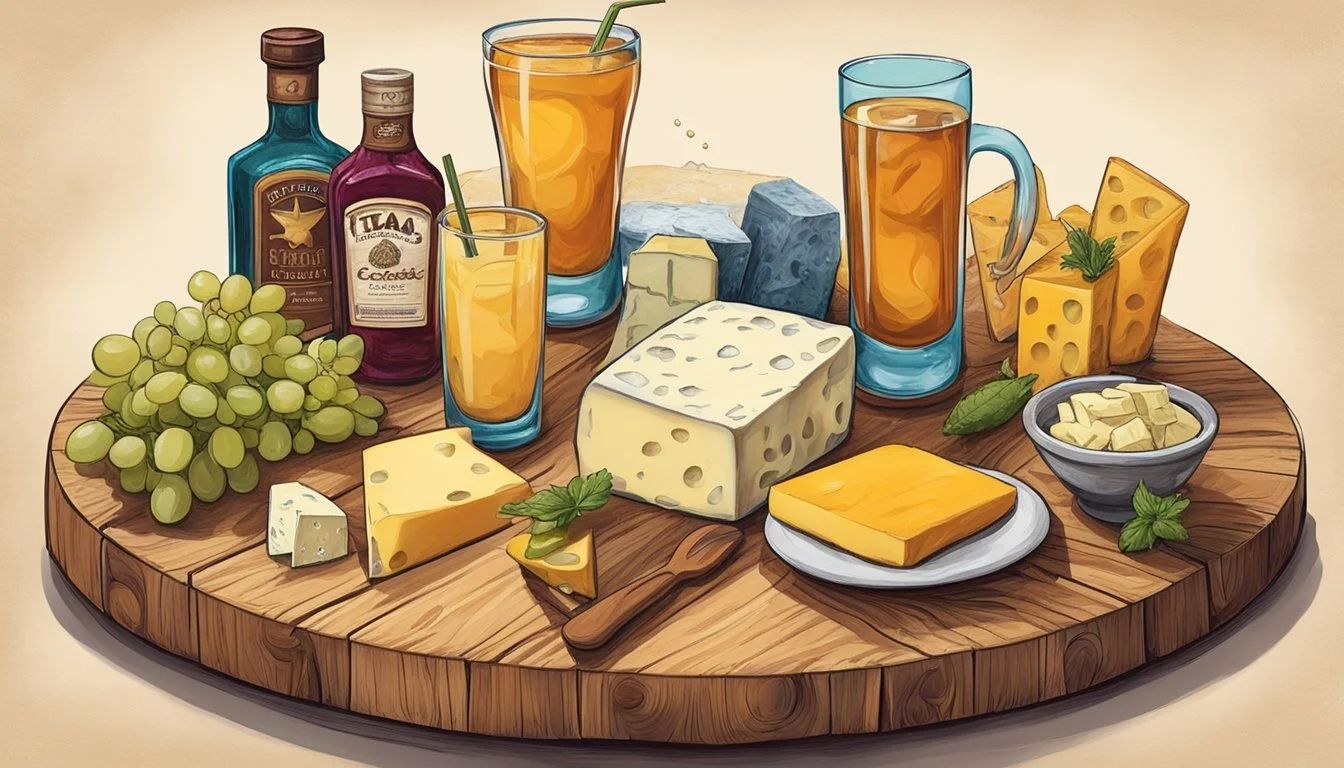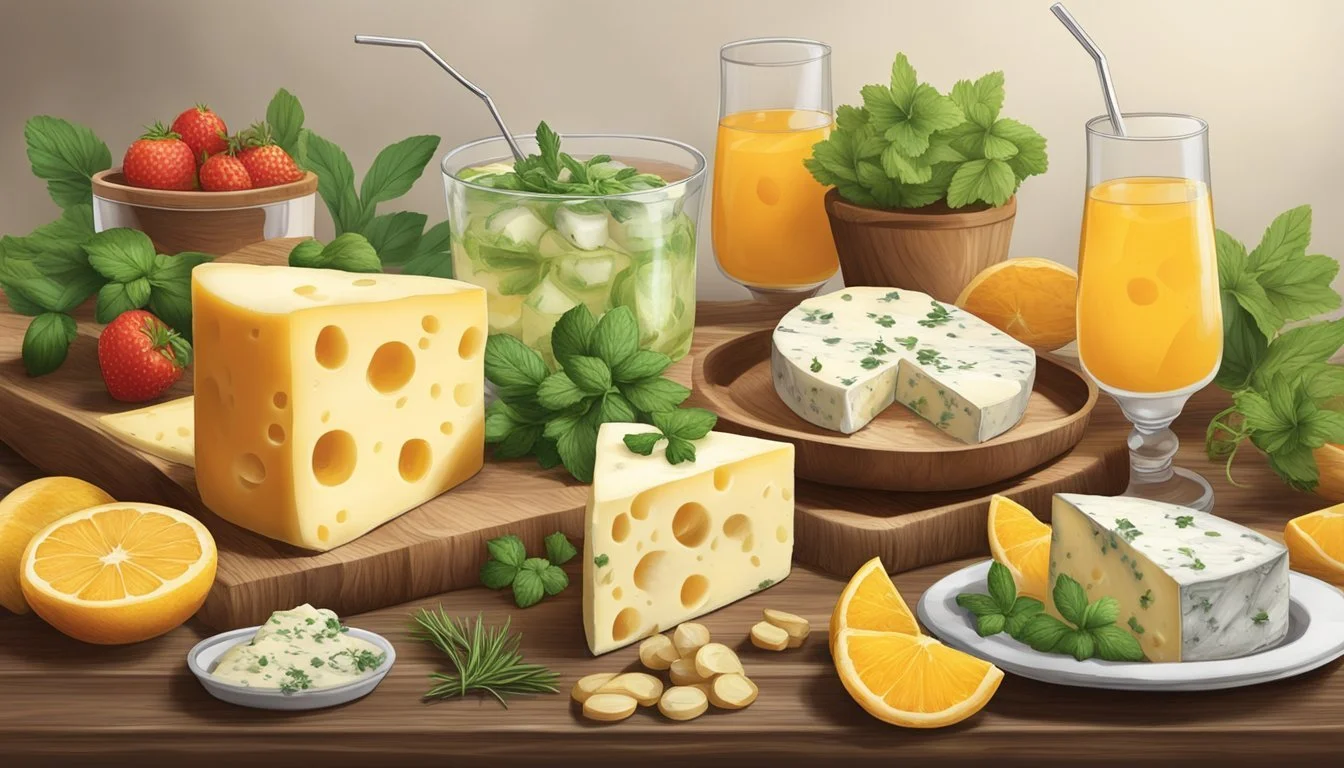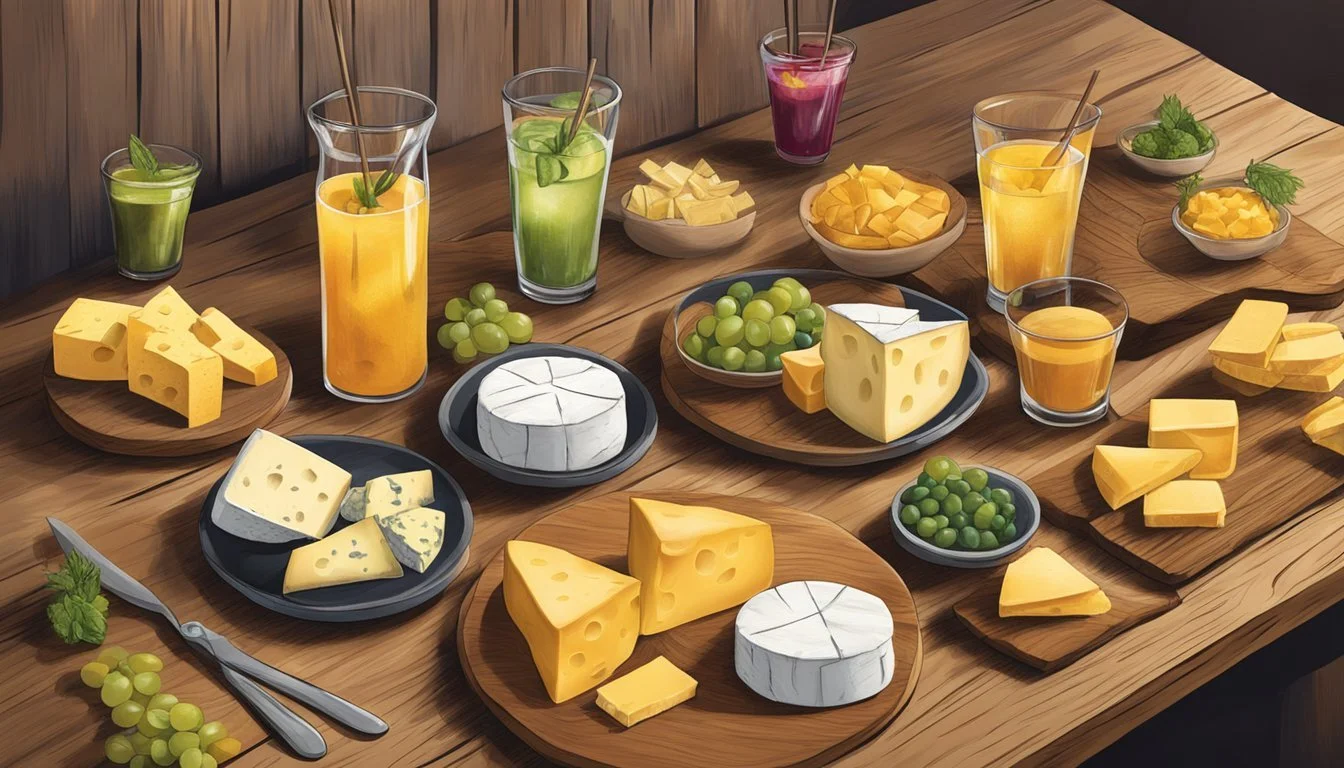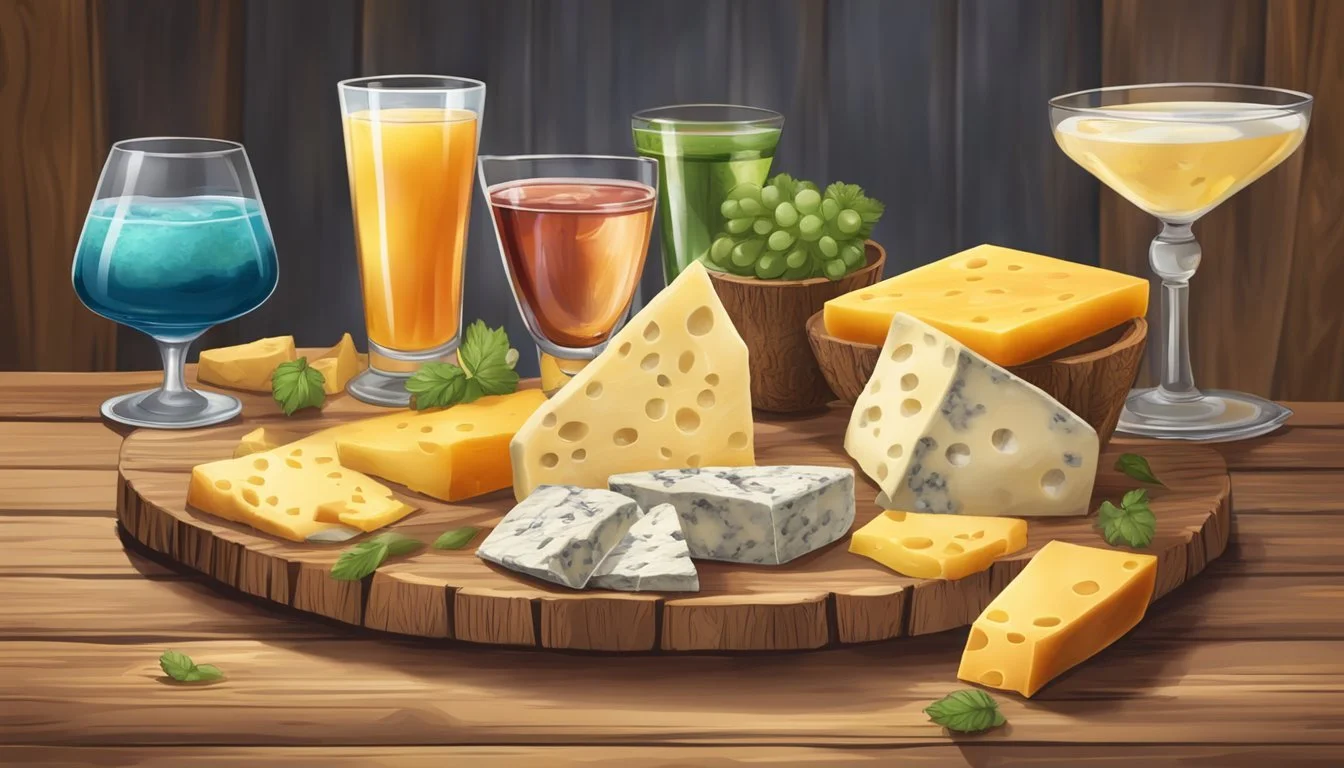The Art of Pairing Texas Cheeses with Cocktails
A Guide for Sophisticated Palates
Pairing cheeses (What wine goes well with cheese?) with cocktails is an art form that tickles the senses and enhances the gastronomic experience, especially when it includes the rich variety of Texas cheeses. The Lone Star State boasts a repertoire of bold and diverse cheeses that reflect its unique culinary heritage. From creamy chèvre to bold cheddar, Texas cheese makers craft an array of flavors suited for complex cocktail pairings.
Texas spirits have gained prominence, with local distilleries producing high-quality gins, whiskeys, and other base spirits that serve as the foundation for inventive and refreshing cocktails. These crafted beverages offer a spectrum of notes, from sweet and floral to smoky and herbaceous, which can complement or contrast the textures and flavors of artisanal cheeses. As a guideline, the pairing should enhance both the drink and the cheese, creating a harmonious balance on the palate.
A cheese and cocktail pairing experience is not just about the flavors; it is a sensory journey. The creaminess of a soft cheese juxtaposed with the crispness of a chilled cocktail, or the savoriness of aged cheese with the nuanced warmth of whiskey, creates memorable contrasts. It invites aficionados to explore the ways Texas cheeses can be matched with both classic and novel cocktails to elevate the simple act of sipping and tasting into a culinary adventure.
Understanding Cheese and Cocktail Basics
Pairing Texas cheeses with the right cocktails requires an understanding of the unique characteristics of both elements. A harmonious pairing enhances the flavors and textures, creating a symphony of taste that celebrates the craftsmanship of cheese-making and mixology.
Cheese Fundamentals
Texas cheeses come in a variety of flavors and textures, which can range from the creamy, buttery notes of a soft Brie-style cheese to the robust, piquant bite of an aged Cheddar. Texture is just as important, influencing how a cheese interacts with different spirits. Cheeses with a higher fat content tend to pair well with stronger-flavored cocktails because the fat can balance out the alcohol's burn.
Flavor Profile: The intensity of the cheese's flavor should be matched appropriately with the cocktail.
Texture: Consider how the cheese’s firmness or creaminess will complement the cocktail's body.
Cocktail Essentials
Cocktails are a blend of spirits, other ingredients like juices and syrups, and garnishes, which altogether create a complex drink with various layers of flavor. The base spirit is the foundation of any cocktail and its flavor profile plays a critical role in the pairing process.
Base Spirits: Whiskey, gin, vodka, and tequila all offer different flavor profiles and alcohol contents.
Ingredients: Additional components such as bitters, citrus, or herbal elements can alter the spirit's flavor and should be factored into the pairing.
Alcohol Content: A cocktail with higher alcohol content can cut through the richness of creamier cheeses, whereas lighter cocktails might pair better with subtle cheese flavors.
Flavor Profiles and Pairing Principles
In the practice of pairing Texas cheeses with cocktails, understanding the flavor profiles and how they complement or contrast with various drink elements is essential. The aim is to achieve a balance that elevates both the cheese and the cocktail.
Balancing Flavors and Textures
When pairing cocktails with cheese, the texture and intensity levels of both components should be considered to ensure neither overwhelms the other. A rich and creamy cheese such as Texas Brie pairs well with a cocktail that has a smooth, velvety texture, like a Whiskey Sour. Conversely, semi-hard cheeses with a bit more flavor depth, such as Greens Creek Gruyere, require a drink that matches this intensity, such as a cocktail with a moderate degree of acidity or sweetness.
The Role of Acidity, Sweetness, and Spice in Pairings
Acidity, sweetness, and spice play crucial roles in complementing or contrasting the flavor profile of cheese.
Acidity: It can cut through the fattiness of cheese, providing a refreshing palate cleanser. A goat cheese (chèvre) with a bright, lactic tang pairs beautifully with the slight acidity present in a Gin & Tonic.
Sweetness: This aspect in cocktails can balance the saltiness of cheese. Sweet notes in cocktails like a French 75 might complement the subtle sweetness in a fresh chèvre.
Spice: A drink that has a spicy kick can contrast nicely with a buttery cheese, offering a layered tasting experience.
The key to successful pairings is to avoid any one taste overpowering the other. Instead, they should interact harmoniously, creating a unified and enhanced flavor experience.
Cheese Varieties and Their Cocktail Companions
Pairing cheeses with the right cocktail can amplify the flavors and create a delightful tasting experience. The unique characteristics of Texas cheeses, ranging from soft to intense, align well with specific cocktails that match their flavor profiles.
Soft Cheeses: From Brie to Mascarpone
Soft cheeses like Brie and Mascarpone are known for their creamy textures and mild flavors. These cheeses pair well with cocktails that have a light and fruity touch.
Brie: Complement this cheese with a classic Bellini, where the peach purée echoes Brie’s soft nature.
Mascarpone: Opt for a Raspberry Limoncello Prosecco, balancing Mascarpone's richness with a sweet and tart cocktail.
Aged and Intense: Gouda to Blue Cheese
Aged cheeses (What wine goes well with aged cheeses?) possess deeper, more robust flavors that require cocktails with a similar intensity to match.
Aged Gouda: An Old Fashioned enhances the smoky, caramel notes of aged Gouda with its bourbon base.
Blue Cheese: A Port Wine Manhattan can stand up to the strong, tangy flavor of blue cheese, creating a harmonious blend.
Versatile Pairs: Cheddar and Manchego
Cheddar and Manchego can vary in flavor depending on their age, but they tend to offer a balanced richness that can be paired with diverse cocktails.
Cheddar:
Young Cheddar: A herbal Gin and Tonic uplifts the cheese’s subtle flavors.
Aged Cheddar: A more robust Smoky Scotch aligns with the cheese's intensity.
Manchego:
Mild Manchego: A sweet and spicy Sangria complements its subtle nuttiness.
Aged Manchego: Pair with a full-bodied Rioja to bring out the depth in both the cheese and the drink.
Signature Cocktails and Cheese Pairings
Pairing cheeses with cocktails is a culinary art that can elevate the flavors of both the drink and the cheese when done correctly. Each pairing aims to complement or contrast the unique profiles of Texas cheeses with the depth and character of various cocktails.
Classic Cocktail and Cheese Matches
Old Fashioned and Smoked Cheddar: The robust flavors of bourbon, bitters, and citrus in an old fashioned complement the boldness of Texas smoked cheddar, enhancing its rich, smoky notes.
Gin and Tonic with Herb-Coated Goat Cheese: A classic gin and tonic, with its clean and crisp botanicals, pairs splendidly with the tangy and fresh flavors of a Texas herb-coated goat cheese.
Manhattan and Blue Cheese: The sweet vermouth and whisky in a Manhattan enhance the pungent and spicy flavors of a creamy Texas blue cheese, creating a harmonious balance.
Aperol Spritz and Pepper Jack: The lively, citrus notes of an Aperol Spritz cut through the spicy, creamy texture of Texas Pepper Jack cheese.
Artisanal Twists: Craft Cocktails and Unique Cheeses
Bloody Mary with Aged Gouda: An elaborate Texas Bloody Mary, often spiced with local flavors and even smoked meats, pairs unexpectedly well with the rich, caramelly notes of an aged Gouda.
Negroni and Pimento Cheese: The bold, bitter flavors of Campari in a Negroni contrast nicely with the creamy, sweet, and slightly spicy complexities of Texas-style pimento cheese.
Paloma and Queso Fresco: The refreshing and slightly bitter Paloma, with its grapefruit and tequila base, pairs exquisitely with the mild and milky Texas queso fresco.
Rum Daiquiri and Tropical Cheddar: A simple rum daiquiri with its sweet and tart profile brings out the fruity undertones in a cheddar infused with tropical Texan fruits like mango and pineapple.
Seasonal and Regional Pairing Suggestions
In Texas, the art of pairing cheeses with cocktails is a celebration of regional produce and seasonal flavors. One can experience a diverse array of bold, refreshing, and nuanced drink and cheese combinations that capture the state's culinary spirit.
Summer Delights: Light and Fruity Combinations
During summer, light and fruity cocktails paired with local cheeses create a refreshing experience. A Texas-favorite like The Blue Jay, featuring lemon juice and blueberry syrup, can be paired beautifully with a creamy goat cheese, offering a delightful contrast between the zesty, sweet cocktail and the tangy cheese.
Pairing Table for Summer:
Cheese Cocktail Description
Fresh chevre Blueberry Mojito The brightness of mint and blueberries complements the smooth texture of the goat cheese.
Feta Watermelon Fizz Salty feta pairs nicely with the sweet, refreshing taste of watermelon-based cocktails.
Local Flavors: Regional Cheeses and Spirits
For those seeking to indulge in year-round regional offerings, consider matching Sartori Merlot Bellavitano with a crafted Texas whiskey cocktail. This cheese, which has a rich and creamy texture with berry and plum notes from the merlot, stands up nicely to the robust flavors of local spirits.
Pairing Table for Local Flavors:
Cheese Spirit Description
Sartori Merlot Bellavitano® Texas Whiskey The bold notes of a Texas whiskey cocktail enhance the cheese's depth.
By carefully selecting cheeses and cocktails that reflect the summer season and Texas's regional character, one can create a cheese board that is both a gastronomic journey and a testament to the locale's rich agricultural heritage.
Enhancing Pairings with Texas Cheeses with Cocktails
When crafting a cheese board to accompany Texas cocktails, the addition of carefully chosen components can enhance the overall flavor experience. These elements should complement the primary pairing of cheese and cocktails, providing a full spectrum of tastes and textures.
Accenting with Herbs, Nuts, and Fruit
Incorporating herbs, nuts, and fruit into a cheese and cocktail pairing elevates the flavor profile. Delicate herbs like basil or thyme add a fresh contrast to rich cheeses. Pecans, known for their nuttiness, play well with the bold flavors of Texas cheese, especially when they are toasted or candied.
Fruit offers a natural sweetness and acidity that can bring balance. For example, cheese with honey drizzled over it pairs beautifully with a whiskey cocktail that has a hint of pineapple or lime juice. Similarly, orange marmalade can provide a bittersweet counterpoint to a creamy cheese, especially when paired with a citrus-forward gin cocktail.
Component Cheese Pairing Cocktail Pairing
Basil Fresh mozzarella herbal gin cocktail
Pecans Aged cheddar bourbon with a nutty profile
Honey Brie whiskey and pineapple cocktail
Pineapple Smoked gouda rum cocktail
Completing the Board: Meats and Other Additions
The addition of savory meats can turn a simple cheese pairing into a substantial offering. For instance, the addition of prosciutto with its subtle saltiness complements soft cheeses and can stand up to cocktails with more pronounced spices.
For a spicy kick, one might add chorizo with paprika notes which pair well with the creamy nuttiness of a semi-hard cheese, matched with a cocktail that has a bit of heat or smoke.
Completing the board with these components is both an art and a science, ensuring that each sip and bite is a unique experience.
Addition Cheese Pairing Cocktail Pairing
Prosciutto Goat cheese Martini with a twist of lemon
Chorizo Manchego Smoky mezcal cocktail
Presentation and Serving Tips
Crafting the perfect Texas cheese and cocktail experience relies heavily on thoughtful presentation and expertly executed serving techniques. A cheese board should not only tantalize the taste buds but also please the eye, while cocktails, skillfully mixed, elevate the pairing to an art form.
Building the Perfect Cheese Board
When arranging a cheese board, the first step is to select quality local Texas cheeses, ensuring a variety of textures and flavors. Each cheese should be served at room temperature for optimal taste. Cheeses should be spaced out, and each should come with its own knife to avoid flavor cross-contamination. Accompaniments are crucial; include a mix of salty and sweet elements such as:
Crackers/Breads: Offer an assortment from crusty baguette slices to flavored crackers.
Fresh/Dried Fruits: Seasonal fruits like figs and berries add freshness, while dried fruits offer a chewy contrast.
Nuts: Pecans or almonds provide a crunchy texture.
Garnishes: Fresh herbs like dill or basil can enhance both the cheeses and cocktails.
Photographer and writer Jeanette Hurt recommends on Instagram the use of garnishes that pair aesthetically and flavor-wise with the cocktails being served.
Cocktail Crafting Techniques
For cocktails, precision is key to achieving the perfect balance and complement to the cheeses. When making a classic Margarita or a refreshing French 75, always use fresh ingredients and adhere to the correct proportions. Cocktails should be:
Well Chilled: Use plenty of ice when shaking or stirring to ensure the drink is cold.
Properly Strained: Use a fine-mesh strainer or cheesecloth to prevent unwanted pulp or ice shards in the drink.
Professionally Presented: A clear glass displays the cocktail's color and composition, and an appropriate garnish enhances both the flavor and appearance.
If creating an Espresso Martini, the visual layering effect will be as important as the taste, requiring a meticulous pouring technique. Each cocktail should be served immediately after mixing to maintain its integrity and temperature, enhancing the overall tasting experience.
Understanding the Science of Pairings
The art of pairing involves a deep understanding of how flavors and textures interact between cheeses and cocktails. The complexity and intensity of both components must be considered to achieve a harmonious experience.
Chemistry of Taste in Cheese and Cocktails
The fundamental aspect of pairing lies in the chemistry of taste. Cheeses come with a range of flavors -- sweet, salty, and tangy -- and a variety of textures from creamy to crumbly. Cocktails, diverse in their profiles, encompass sweet, sour, bitter, and spicy notes through their mix of spirits and mixers.
Sweetness in honey-infused cheeses pairs with the sweetness in a cocktail, enhancing the flavor without overpowering it.
Spicy cheeses benefit from a cocktail with a touch of sweetness to balance the heat.
Tangy, acidic cheeses can be matched with cocktails that contain a citrus or tart element, amplifying the refreshing qualities of both.
Understanding this chemistry helps in creating pairings where the individual characteristics of the cheese and the cocktail complement each other to produce a well-balanced palate sensation.
Matching Intensity and Complexity
When selecting a Texas cheese and cocktail pairing, one should match the intensity and complexity of both items to avoid one overpowering the other.
Intensity: A strong-flavored cheese requires a cocktail with equal boldness. For instance, a sharp Texas blue cheese would pair well with a robust Manhattan, where the intensity of flavors holds up against each other.
Complexity: Similarly, the complexity of flavors in a cheese should be considered alongside the layers of flavors within a cocktail. A rich and complex aged cheddar pairs nicely with an Old-Fashioned, as the depth of the bourbon and the subtleties of the bitters complement the cheese's intricacies.
One must carefully balance these elements to ensure that the pairings elevate the tasting experience, rather than create a clash that could overshadow the delicate nuances of either the cheese or the cocktail.
Emerging Trends in Cheese and Cocktail Pairings
The landscape of pairing cheeses with cocktails is evolving, driven by the proliferation of craft cocktails and artisanal cheeses, and amplified by the influential role of social media in food culture.
The Rise of Craft Cocktails and Boutique Cheeses
Craft cocktails, characterized by their innovative use of botanicals and high-quality spirits, are increasingly being paired with locally-produced, boutique cheeses. Artisanal cheese producers in Texas, such as those crafting triple cream cheeses, are finding a place in this niche alongside expertly mixed drinks. Take, for instance, "The Blue Jay" cocktail—a concoction blending botanical gin with vibrant, fresh flavors. This particular craft cocktail aligns perfectly with a creamy, decadent triple cream cheese, where the rich texture and the botanical notes can contrast and complement each other exquisitely.
Craft Cocktails: Often include botanicals; pair well with full-flavored cheeses.
Boutique Cheeses: Include varieties like triple cream; offer unique taste profiles.
Influence of Social Media and Food Culture
Social media platforms, especially Instagram, have become key in popularizing the combination of cheese and cocktails. Influencers, including food writers like Jeanette Hurt, demonstrate how to pair beverages and cheeses, which encourages experimentation among their audiences. Wisconsin Cheese, renowned for its wide array of cheese styles, often features in these high-visibility pairings, suggesting potential pairings like a Wisconsin cheddar with a classic Margarita, where the saltiness and sharpness of the cheese cut through the sweet and sour cocktail profile.
Social Media Platforms: Mainly Instagram.
Key Influencers: Jeanette Hurt and others.
Popular Pairings: Margaritas and Wisconsin Cheese—a bold, yet balanced combination.
Expert Insights and Resources
When exploring the art of pairing Texas cheeses with cocktails, one can benefit greatly from professional insights and tailored strategies. Resources are abundantly available for those seeking to enhance their gastronomic experiences.
Professional Opinions on Pairing Strategies
Experts such as Jeanette Hurt, a seasoned author on cheese pairing, emphasize the importance of matching flavor profiles. For instance, a cheese with a robust profile like a sharp Texas cheddar might be complemented by a spirit with a similar intensity. Professional pairing strategies often involve considering the texture and fat content of the cheese alongside the cocktail’s components, like its acidity or sweetness.
Intense cheeses with spirits of equal boldness
Texas Blue Cheese with a richly herbed gin cocktail
Smoked Gouda with a whiskey-based drink featuring smoky notes
Lighter cheeses often pair with more delicate or refreshing cocktails
Fresh Texas goat cheese with a citrusy, herbal gin and tonic
Further Reading and Educational Material
The enthusiast seeking deeper knowledge should delve into educational material from various sources:
Books:
“The Art of the Cheese Plate” for food pairings
Jeanette Hurt’s writings for insightful pairing anecdotes and tips
Online Resources:
Blogs by cheese experts for current trends
Websites of Texas cheese makers for specific cheese profiles
By studying these materials, one can develop a more nuanced understanding of cheese and cocktail pairings, transforming a simple snack into an artful culinary experience.

